15 Little Known Facts About Elephants
Elephants are the largest land-living mammals on earth and are classified
into two distinct varieties; the African elephant and the Asian elephant. The
elephant has played dynamic roles in religion and culture, and some regard
them as practically deities. In Asia, elephants began their integration with
human civilization as a means of powerful logistical transportation. Moving
everything from stones and supplies during peace time, elephants first began
their relationship with human beings in the region that today is known as India.
During warfare, elephants were used by the heavy cavalry of Alexander the Great
and the premise of using what's known as a war elephant was used by the armies
of Hannibal and Carthage.
Female African Elephant
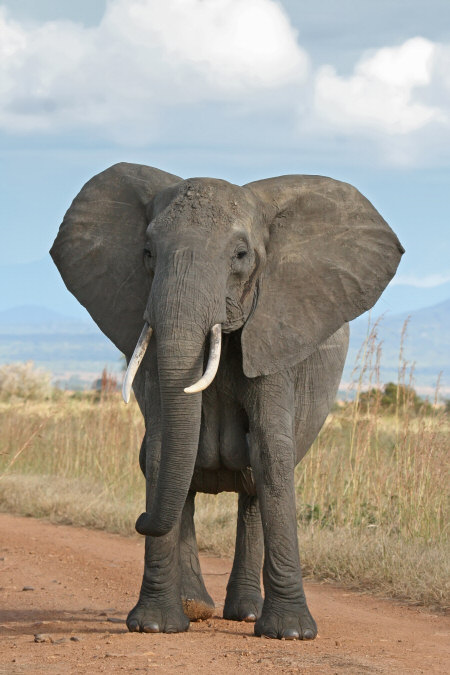
By Muhammad Mahdi Karim
via Wikimedia Commons
Along with all of the positive and symbiotic relationships between man and
elephant, unfortunately elephants have also been brutalized, poached, and
perceived as nothing more than worthless flesh attached to priceless ivory. Both
female and male African elephants have tusks, but only the male Asian elephants
have tusks.
East African Ivory Traders During the 1880s
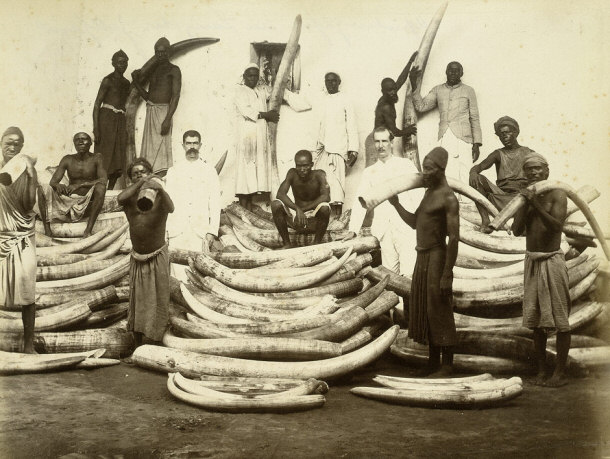
Demand for ivory, combined with habitat loss caused by human
settlements, has pushed worldwide elephant populations down to alarmingly small
numbers. Back in the 1930s, the African elephant population was estimated
between 5 and 10 million. By the year 1979, there were only 1.3 million African
elephants.
(1) Asian Elephant and (2) African Elephant
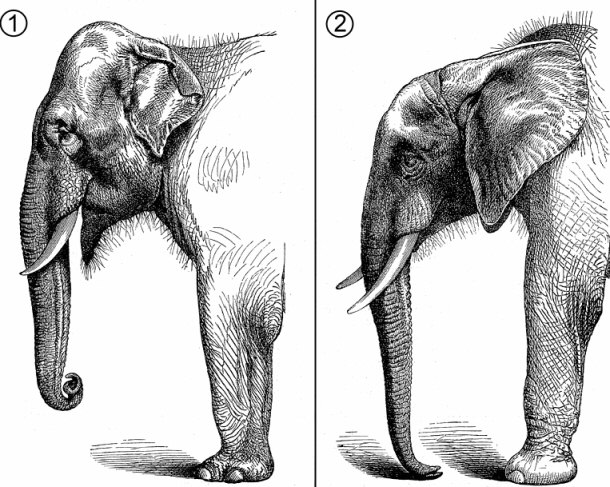
Although both varieties of elephant are considered to be endangered, Asian
elephants are currently much more endangered than their African cousins. Around
the year 1900, the Asian elephant population was estimated to be around only
200,000 worldwide. The scary part is that today, there are probably no more than
only 35,000 to 40,000 remaining in the wild.
Male Indian Elephant
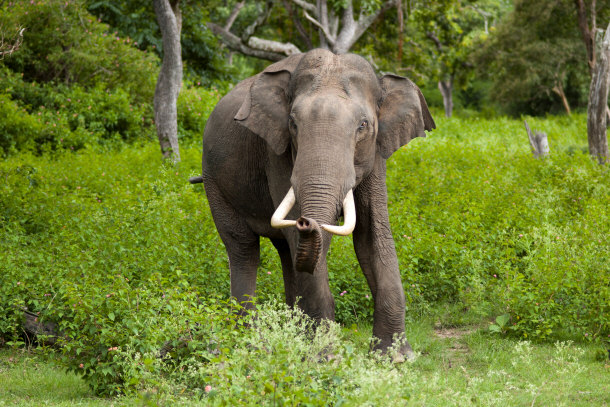
By Yathin S Krishnappa
via Wikimedia Commons
In spite of the endangerment issues both varieties of elephants may face,
appreciation and reverence for elephants are still very popular among human
beings. People are drawn to these fascinating creatures and
desire to learn as much as they can about them. Obvious characteristics include
their large size, surprising speed and agility, and their unique trunks. Still,
there is much more to the animal than many people may have postulated based on
the information regarding elephant-lore that is readily available. The segments
below address some of these less prevalent pieces information regarding
elephants.
15) Elephants Walk on Their Tiptoes
Elephants are simply staggering in size. Adult male African elephants can weigh
between 4,000 and 14,000 lbs or 2 to 7 tons. It’s remarkable to think that an elephant’s foot is made up
in such a way that it basically walks on its tiptoes. The sole of an elephant’s
foot consists of soft connective tissue.

By Psych USD
via Wikimedia Commons
This allows the sole of the animal’s
feet to work like a shock absorber. This also enables the animal to move almost
silently, despite its massive size and weight.

By Jpatokal
via Wikimedia Commons
The elephant’s foot is also contoured in such a way that it muffles the sound
of cracking branches under its feet. The unusual make up of the elephant’s foot
also allows the animal to traverse a number of different types of terrain with
relative ease.
14) Elephants’ Trunks Have More Than 40,000 Muscles
The most distinctive feature of an elephant is by far their trunk. It is an
extremely useful feature that the animal can use for a variety of things. An
elephant's trunk is able to sense the size, shape, and temperature of an object. The
organ can be used to pick up things, strip branches of their leaves and even
uproot trees if need be.
Asian Elephant's Trunk

By Greg George
via Wikimedia Commons
It’s no wonder then that an elephant’s trunk has more
than 40,000 muscles. This is in fact more muscles that the human body has. An
elephant’s trunk has so many muscles in it that the tip of the trunk can even be
used in a similar fashion to how humans control and use their hands. The same
way in that humans use shaking hands as a greeting method, elephants intertwine
their trunks to greet one another.
Asian Elephants Greeting Each Other
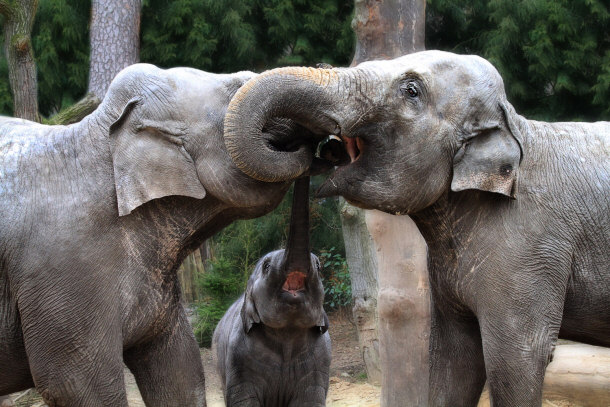
By jinterwas
via Wikimedia Commons
13) Elephants Have the Longest Gestation of Land Animals
Beyond poaching, one of the biggest threats to the dwindling elephant
population throughout the world is the fact that elephants’ pregnancies are
considerably long. In fact, they last 22 months. This allows for the calf to
grow to an incredible size, so much so that the average weight of a baby
elephant when it is born is around 260 pounds.
Baby African Elephant

It is due to the long pregnancies that female elephants typically only give
birth to a single calf every four years. This makes it difficult to breed a
significant number of elephants in captivity, which is crucial to the animal’s
longevity given all the dangers that the elephant faces in the wild.
Baby Indian Elephant
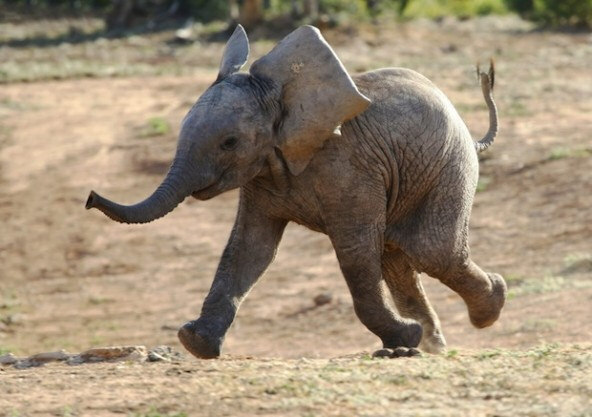
12) Elephants Can Die of a Broken Heart
Elephants are highly emotional animals. Similar to humans, the animals
establish strong relationships with other elephants, so much so that they will
deeply mourn the passing of members of their troop. In some cases, elephants
have died as the result of a beloved troop member passing.
Troop of Elephants
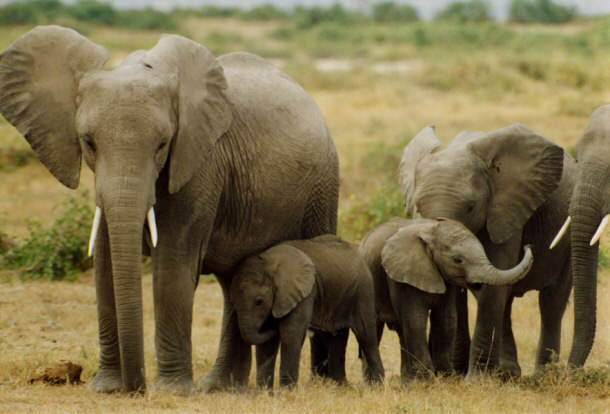
Young elephants are particularly vulnerable to dying of a broken heart. If a
young elephant loses its mother, it may become emaciated and withdraw from
social interaction with the rest of the troop. Other members of the young
elephant’s troop will do their best to care for orphaned animals, though that may
not be enough.
11) Chili Pepper Is the Best Defense Against Wild Elephants
Throughout Africa there has always been a conflict between farmers and wild
elephants. The problem is that elephants will routinely raid local farms. These
raids can happen on a nightly basis and often result in the decimation of crops
and even deaths of farmers and their families.
African Elephant Charging

In 2006, farmers began fighting back using an unlikely source. Namely, chili
peppers. The farmers realized that elephants have an aversion to capsaicin – the
chemical found in chili that makes it hot. The farmers found that all they had
to do to stop the elephants was plant a few rows of chilies around their crops.
These rows would act as a buffer against the elephants.
Member of the Elephant Pepper Development Trust, Loki Osborn came up with the
idea. He was inspired by the results of a similar trial in North America when
pepper spray was used to deter bears. Osborn’s idea was first trialed in Cape
Town, South Africa. As pepper spray was too expensive for most farmers, crops
were planted instead. This proved to be much more beneficial for both farmers
and elephants. It gave the farmers a feasible way to defend their property,
while keeping the elephants away through non-violent means.
White Chili Pepper

By Rayabhari
via Wikimedia Commons
Osborn also showed farmers how make briquettes of crushed chili and manure.
If the elephants weren’t deterred by the chili plants, then these bricks could
be burned. They would create a noxious smoke that ward off the elephants. The
program also made use of string fences that were doused with chili-infused
grease.
With the success of the trial in South Africa, the measures were implemented
in numerous other African nations. Ultimately, crop loss was reduced by around
90 per cent.
The cultivation of chilies also proved to be lucrative for the farmers. A
number of farmers increased their profit by focusing on the production of
chilies rather than other vegetables. This is because vegetables had a limited
market. In contrast, the chili peppers could be used to make hot sauce that is
then exported to a number of countries like Botswana, Zambia and the America.
10) Elephants Are Scared of Bees
As mentioned earlier, African farmers have addressed the problem of elephants
raiding farms by planting chilies. This proved to be a remarkably beneficial
approach to the problem. Prior to the use of chili, though, the farmers had
tried another approach. They had set up beehives around their properties, as
they knew elephants were afraid of bees.
Honeybee

By Fir0002
via Wikimedia Commons
The only reason the bees didn’t work was because the elephants’ hunger was
greater than their fear of the bees. Typically, though, elephants would avoid
bees as best they could. Elephants are afraid of bees because bees will often
fly up elephants trunks and sting them.

Given that bees are so small in size and fast moving, there is little
elephants can do to either defend themselves or retaliate. Elephants regard bees
with such fear that they have even developed a special hum that signals a
warning to other elephants when bees are nearby.
9) Elephants Mourn Their Dead and Have Death Rituals
Elephants are one of the most intelligent animals on the planet. They are
also one of the most human-like. Elephants have been observed exhibiting a
number of human characteristics. They have displayed self-awareness, altruism
and even the ability to use tools. Perhaps the most human of all characteristics
that the animals have displayed is grief.
Most animals have little to no regard for the remains of their peers but
elephants are significantly different. They show great respect for troop members
when they pass. Often, when a member of a troop dies, the remaining elephants
will gather around the body of the departed animal and appear to pay their
respects, as humans do at funerals.
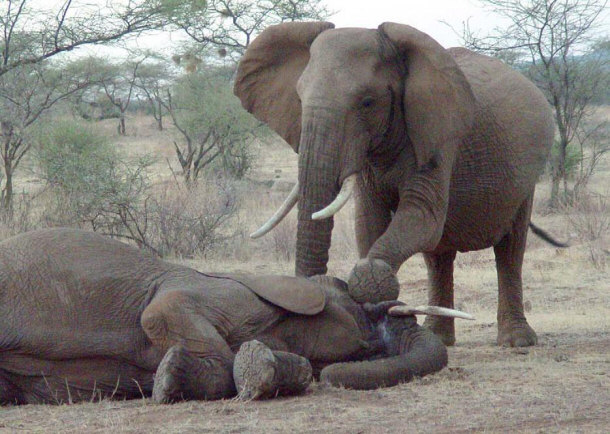
Elephants have even been seen to show respect for the bones of dead
elephants. In one experiment, researchers tested whether African elephants could
distinguish between bones of elephants and bones of other animals such as
buffaloes and rhinos. The elephants were found to be able to recognize the
remains of their own species.
Elephant Troop Mourning the Departed
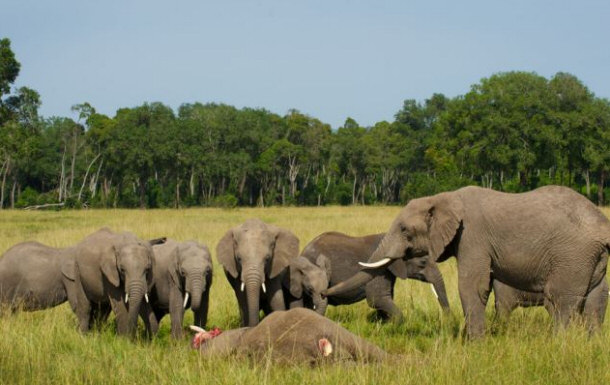
Elephants have strong family ties and have often been seen mourning the loss
of herd members in the wild. Reportedly, a troop of elephants even mourned the
death of the man known as the Elephant Whisperer, Lawrence Anthony. Shortly
after his death, his wife reported that a troop of elephants arrived on their
property – as if to pay their respects to his family. Anthony’s wife stated that
the animals were clearly in mourning and had somehow sensed the death of her
husband.
8) Kings Would Give White Elephants to People They Didn’t Like
In the past, the kings of Siam (now Thailand) had an unwritten tradition of
giving white elephants to people they didn’t like. On the surface, the present
of a white elephant would seem like a grand gesture. In reality, it was a subtle
way for the king to financially ruin those he didn’t care for.
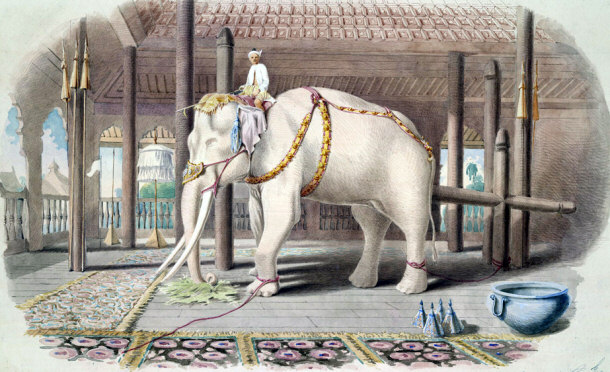
Spiritually, white elephants were considered sacred throughout Southeast
Asia. Possessing a white elephant was seen as a blessing. In reality, they were
quite the opposite, as they required very high levels of maintenance – and a lot
of money. Typically, whenever someone would receive a white elephant, they would
ultimately be unable to care for the expensive animal.
7) Elephants Are Angry Drunks
Elephants have displayed a number of human-like characteristics over the
years. While most of these characteristics are positive, such as altruism and
intelligence, the animals also have some bad human habits. For one thing, a
surprisingly large number of elephants are alcoholics – raging drunks, in fact.
Drunk Elephants

In 2007, a group of six elephants rampaged through an Indian village. They
were after one thing in particular – the village’s supply of alcohol. Once the
animals were well and truly drunk, they set about trashing the village. They
were only stopped by their own drunken actions. They were electrocuted when they
uprooted electrical poles. In 2002, another group of elephants drunkenly
rampaged through another Indian village. This resulted in the death of 6
civilians.
Elephant Passed Out After Bender

Alcoholism amongst elephants isn’t as unusual as it might sound. It is an
ever-growing problem throughout both Africa and India. Elephants are remarkably
intelligent animals. They instinctively know that where there are humans, there
is alcohol. Furthermore, elephants are adept at seeking out alcohol, so hiding
it from the animals is difficult.
6) “Extinct” Pygmy Elephants Were Found in Borneo
In 2008, a small population of genetically distinct elephants was discovered
in Borneo by scientists. The researchers noticed that these elephants were
significantly different in both physicality and personality from other elephants
that they had investigated. As fanciful as it initially seemed, the scientists
explored the possibility that the elephants might be members of a species long
thought extinct. Tests soon confirmed that the animals were indeed, as the
researchers had suspected, pygmy elephants – a species that no longer existed in
their natural habitat.
Orphaned Pygmy Elephant and Wildlife Workers
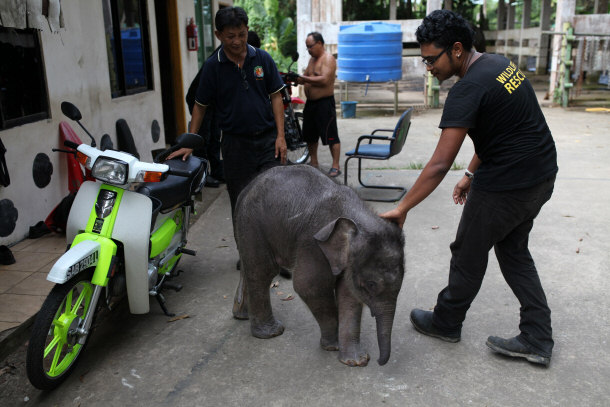
The elephants exist today because of the actions of Asian rulers from
centuries ago. Back then, it was common for rulers to exchange animals as gifts
amongst one another. A small group of pygmy elephants were one such gift
exchanged all those years ago. This inadvertently led to the survival of the
species.
Researchers believe that the elephants were descendents of an elephant
population that initially lived in Java (an island in Indonesia). It’s believed
that they first came from the island of Sulu (now part of the Philippines).
It’s believed that the sultan of Java gave the elephants to the sultan of
Sulu as a gift. For undetermined reasons, descendants of those elephants were
later shipped to and abandoned on Borneo. Meanwhile, back on Java the elephants'
population dwindled. By the end of the 1700s, the pygmy- elephant was believed
to be extinct.
Pygmy Elephant
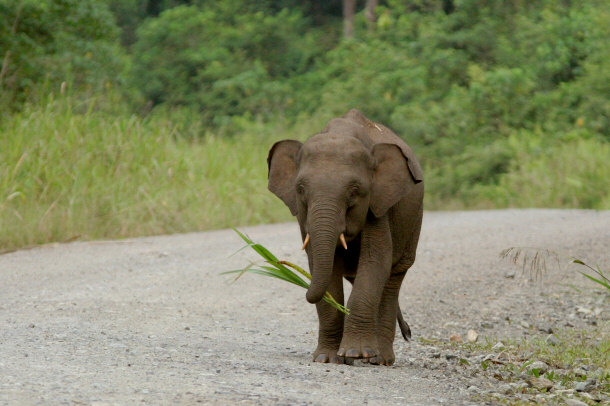
According to Michael Stuewe, an elephant biologist of the World Wildlife
Foundation, the pygmy elephants on Borneo might be the oldest example of a wild
mammal population that was inadvertently saved by royalty. This discovery
suggests that other animals may have also been saved from extinction by removal
from their natural habitat.
5) Elephants Heard the 2004 Indian Ocean Tsunami
In 2004, when the Indian Ocean Tsunami struck, it was reported that elephants
headed for higher ground long before people knew of the imminent disaster. It
was originally reported that the elephants must have sensed that tragedy was
about to strike. Rather, it was because the animals actually heard the tsunami
coming.
Epicenter of the 2004 Tsunami

Before the tsunami struck, it produced very low-frequency sounds, known as
infra-sound. The noise was too low in frequency for human beings to hear.
However, elephants could well and truly hear the noise. They heard the ominous
roar coming from the sea and instinctively headed for higher ground.
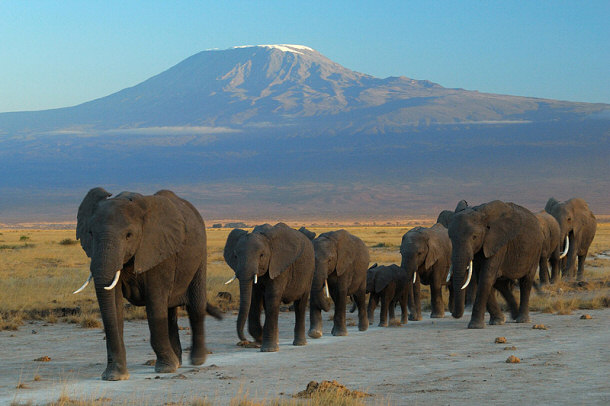
By Amoghavarsha
via Wikimedia Commons
4) Elephants Purr
Elephants are known for their trumpet call that they produce with the use of
their trunks. Elephants also produce a lesser known sound to communicate to one
another. These particular calls are similar to a purring sound that cats make.
They are of a very low frequency, so much so that they are generally too low
pitched for humans to hear.
African Elephant Trunk
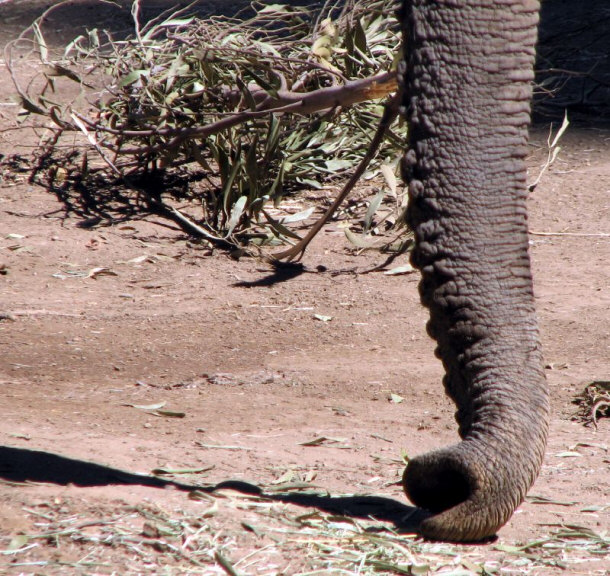
By Just chaos
via Wikimedia Commons
Researchers have been able to monitor elephants’ purr by using specially made
collars that measure the vibrations when the animals make the call. There are a
number of reasons why the animals make these calls. One of the main reasons
female elephants produce the sound is to indicate to the rest of the troop that
she is ready to give birth. This allows the rest of the troop to prepare for and
protect the new baby during and after the event.
3) Elephants Are Therapeutic
In 2011, elephants were utilized to conduct an unusual but remarkable project
for helping children with autism. The project was inspired by the numerous cases
where interaction with dogs had been used to help autistic children as a form of
therapy.
Nuntanee Satiansukpong, the head of the occupational therapy department at
Chiang Mai University in Thailand, believed that the elephants might prove to be
beneficial for autistic children. Specifically, in regards to the sensory issues
that many autistic children struggle with.
Nuntanee Satiansukpong Sitting on an Indian Elephant

Many of the children involved had never seen elephants up close before. The
therapy involved autistic children helping with the care of the animals. The
children helped scrub down the elephants. They also rode and played ball games
with the animals. The children would also sing to the creatures, to which the
elephants would nod their heads to the rhythm of the music.
Each interaction with the animals was carefully designed to help the children
learn social skills. Caring for the animals helped children learn the process of
step-by-step instructions. Feeding the elephants helped the children overcome an
aversion to sticky and rough textures. Playing with the elephants encouraged the
kids to participate in group activities. Riding the elephants addressed poor
posture and balance.
2) Elephants Make Great Camera Operators
Elephants are remarkable animals, capable of performing a number of
surprising tasks. Perhaps the most surprising thing that they are good at is
camerawork. In 2000, elephants were utilized to provide researchers with insight
into the lives of tigers. The elephants were equipped with cameras. This gave
researchers a far greater insight into the behavior of tigers in the wild than
they had ever had before.
The problem researchers had always had when it came to trying to study tigers
in the wild was that tigers are secretive and live in dense jungle. This made it
difficult for any film crew to get footage. Elephants were seen as the perfect
four-by-four camera vehicle. The elephants were specifically trained to use
cameras or “trunk cam” as it was known.
"Trunk" Cam
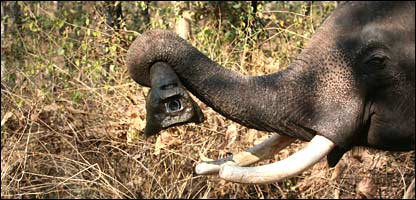
The crew used three types of high-definition cameras, which were developed
and operated by cameraman Michael Richards. There was a remote-operated
trunk-cam that filmed while the elephants were in motion. There was a
remote-operated tusk-cam that the elephants could carry. There were also rock
and log cams, which were cameras camouflaged as either a rock or log that could
be placed anywhere on the ground and activated by motion.
The elephants also proved to be much like steady-cams. The elephants only
required a small amount of training to learn to carry and set the cameras down.
With the help of the elephants, everything the tigers did was captured.
Ultimately, the elephants proved to be the ultimate filming devices. The
tigers were familiar with and unthreatened by the elephants. As such, the
elephants were able to get closer to the tigers than any human being ever could
have. As a result, the researchers were able to follow the growth of four
tigers.
Photograph from "Trunk" Cam

This sort of thing hadn't been done before. The cameras captured footage of a
variety of other animals, including sloth bears, langur monkeys and red dogs.
The footage was filmed in the Pench National Park in India, over the course of
three years. The researchers obtained footage of the tigers from the time they
were cubs right up into their adulthood. The footage was made into a program
that was broadcast as a three-part series. It aired on BBC One and was called
‘Tiger: Spy in the Jungle’ (2008), with Sir David Attenborough narrating it.
1) Elephants Are Evolving Smaller Tusks
Due to the demand for ivory amongst criminals, the elephant population
throughout Africa has more than halved in the last 40 years. There have been a
number of organizations that have done all they can to try and stop the illegal
practice of poaching elephants for their ivory tusks. Some efforts of humans
have proved to be effective. Others have struggled to make an impact. In 2008,
it was discovered that elephants themselves are doing something to counter the
ivory trade. Namely, they’re evolving to have smaller tusks.
African Elephant with Large Tusks
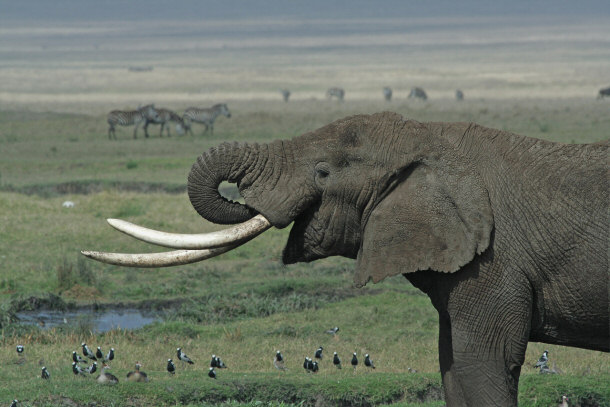
By Unununium272
via Wikimedia Commons
The average tusk size of African elephants has halved since the mid 1800s.
Furthermore, a similar trend has been noted in the Asian elephant population in
India. Conservation experts claim the phenomenon is Darwinism in action,
triggered by the mass slaughter of dominant male elephants. Shockingly, although
evolution typically occurs over thousands of years, these changes have occurred
over the course of just 150 years.
Zoologists at Oxford University believe that the slaughter of the largest
male elephants has altered the breeding behavior of the animals. Researchers
found that the full scale hunting of large males led to males with shorter tusks
producing more offspring. As a result, the average tusk size of African
elephants has since decreased overall.
African Elephant Grazing in Kruger National Park, South
Africa
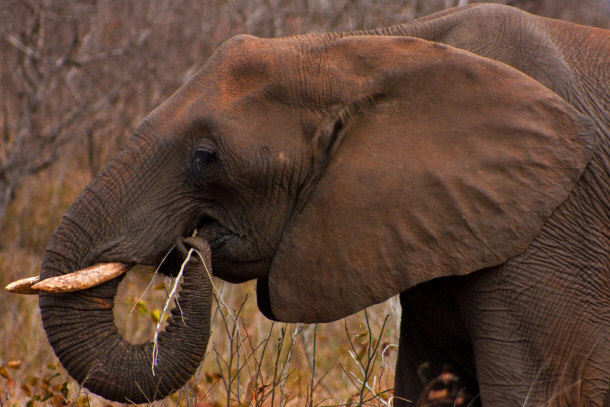
By freestock.ca
via Wikimedia Commons
Iain Douglas Hamilton, of the conservation charity Save the Elephants, said
that the phenomenon may simply be due to an absence of older animals breeding.
However, it is also possible that there has been a genetic selection pressure
against large tusk size. Typically, larger tusks would serve as a means of
fighting off other males and winning females. Nowadays, large tusks are
practically a death sentence for an elephant, as they are so highly prized and
rare. It’s possible that elephants have evolved smaller tusks, because the need
for survival outweighs the usefulness of having larger tusks.
Conclusion
The impact elephants have had on a number of cultures throughout the world is
as massive as the creatures themselves. Sadly, they’ll leave an even bigger gap
in the world if the highly threatened species is ever wiped out entirely, which
could easily happen and soon. They are by far one of the most complex and
fascinating animals on the planet. There is little doubt that there are still
plenty more remarkable facts to be discovered about elephants.
Nature
Top Lists:
15 Fascinating Facts about the Amazon Rainforest
15 Remarkable Facts About Bacteria
15 Remarkable Facts About Jellyfish
15 Little Known Facts About Elephants
15 Fascinating Facts about Earthquakes
15 Odd And Interesting Facts about Monkeys
Top 15 Myths about Snakes
Top 15 Myths about Horses
Top 15 Creepy Deep Sea Creatures
15 Unexpected Animals That Can Kill You Quickly
Top 15 Spider Myths
15 Beautiful Animals that are Now Extinct
Top 15 Most Amazing Snakes Around the World
15 Fascinating Facts about Snow
Top 15 of the World's Rarest Flowers
10 Most Emotional Animals
15 of the Most Venomous Creatures to Roam the Earth
15 Unusual Animal Defense Mechanisms
15 Unusual and Less Known Uses of Rocks
15 Unique Forest Creatures Less Known To Man
15 Interesting Facts About Time
15 Unknown Parasites You Never Knew Existed
15 Weird Trees Around The World
15 Wild Animals Deadly to Humans
15 Exotic Insects That Are Harmful & Deadly
15 Ridiculous Uses for Gold
Informational:
Preparing for a Disaster
Proof That We Are What We Are!
What is the Meaning of Life?
The Trend and Challenges Facing the Urban World
Creation Narratives and the Evolution Creationist Debate |